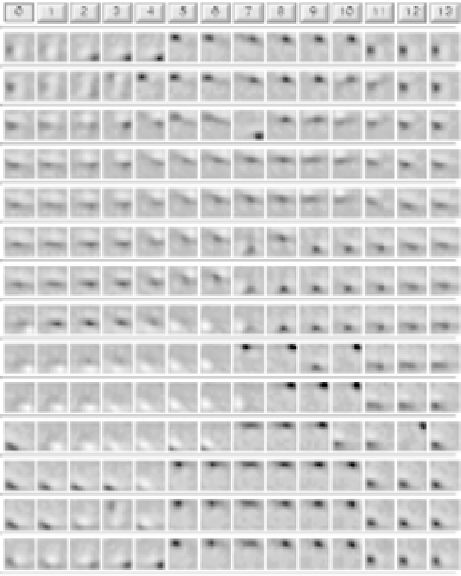Information Technology Reference
In-Depth Information
Support for the heterarchical view over the hierarchi-
cal one comes from a comparison between the represen-
tations produced by various learning mechanisms and
primary visual cortex representations. To show that the
hierarchical view is inconsistent with these visual cor-
tex representations, Olshausen and Field (1996) ran the
SPCA algorithm on randomly placed windows onto nat-
ural visual scenes (e.g., as might be produced by fixat-
ing randomly at different locations within the scenes),
with the resulting principal components shown in fig-
ure 4.8. As you can see, the first principal compo-
nent in the upper left of the figure is just a big blob,
because SPCA averages over all the different images,
and the only thing that is left after this averaging is a
general correlation between close-by pixels, which tend
to have similar values. Thus, each individual image
pixel has participated in so many different image fea-
tures that the correlations present in any given feature
are washed away completely. This gives a blob as the
most basic thing shared by every image. Then, subse-
quent components essentially just divide this blob shape
into finer and finer sub-blobs, representing the residual
average correlations that exist after subtracting away the
big blob.
In contrast, models that produce heterarchical repre-
sentations trained on the same natural scenes produce
weight patterns that much more closely fit those of pri-
mary visual cortex (figure 4.9 — we will explore the
network that produced these weight patterns in chap-
ter 8). This figure captures the fact that the visual sys-
tem uses a large, heterogeneous collection of feature
detectors that divide images up into line segments of
different orientations, sizes, widths etc., with each neu-
ron responding preferentially to a small coherent cate-
gory of such line properties (e.g., one neuron might fire
strongly to thin short lines at a 45-degree angle, with ac-
tivity falling off in a graded fashion as lines differ from
this “preferred” or prototypical line).
As Olshausen and Field (1996) have argued, a repre-
sentation employing a large collection of roughly equiv-
alent feature detectors enables a small subset of neurons
to efficiently represent a given image by encoding the
features present therein. This is the essence of the argu-
ment for
sparse distributed representations
discussed in
chapter 3. A further benefit is that each feature will tend
Figure 4.9:
Example of heterarchical feature coding by sim-
ple cells in the early visual cortex, where each unit has a pre-
ferred tuning for bars of light in a particular orientation, width,
location, and so on, and these tunings are evenly distributed
over the space of all possible values along these feature di-
mensions. This figure is from a simulation described in chap-
ter 8.
to be activated about as often as any other, providing a
more equally distributed representational burden across
the neurons. In contrast, the units in the SPCA represen-
tation will be activated in proportion to their ordering,
with the first component active for most images, and so
on.
One way of stating the problem with SPCA is that it
computes correlations
over the entire space of input pat-
terns
, when many of the meaningful correlations exist
only
in particular subsets of input patterns
.Forexam-
ple, if you could somehow restrict the application of the
PCA-like Hebbian learning rule to those images where
lines of roughly a particular orientation, size, width,

Search WWH ::

Custom Search